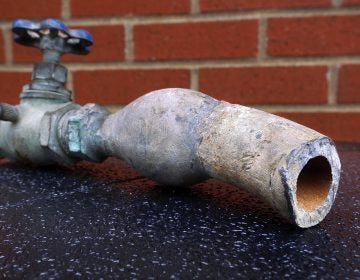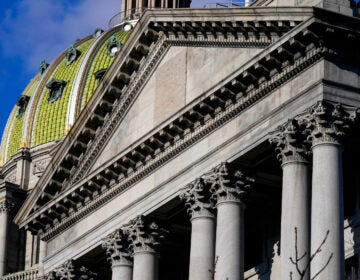Enemy No. 1 for Puerto Rico’s utility: trees
One of the most complicated pieces of technology — the power grid — is no match for the forest.
Listen 7:28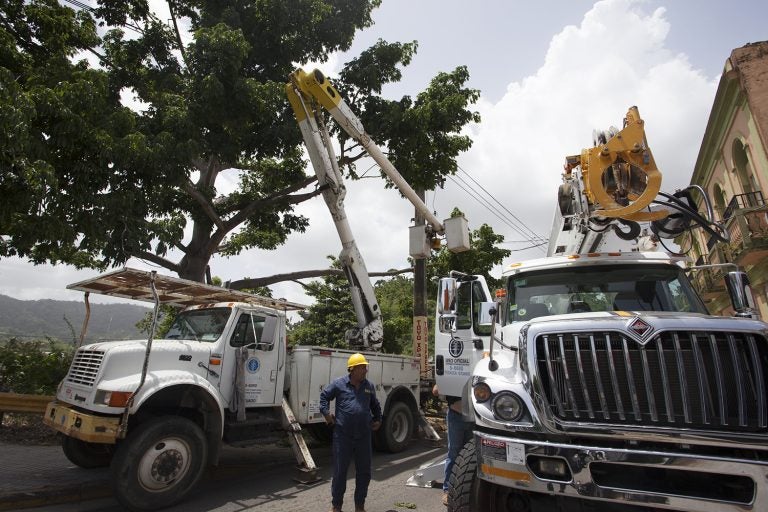
Workers from the power company, PREPA, work on a downed line in Utuado. Branches from a tree fell on the line, breaking it and causing a transformer to explode. (Irina Zhorov/WHYY)
Nine months after Hurricane Maria, Julio Alvarado Feliciano was still working hard to restore power to Tanama, a community in the central Puerto Rican mountains. Feliciano is a technician with the island’s power utility, PREPA. His team reinstalled fallen utility poles and unspooled fresh cable on the ground. Then, the workers tried to haul the lines up from the ground.
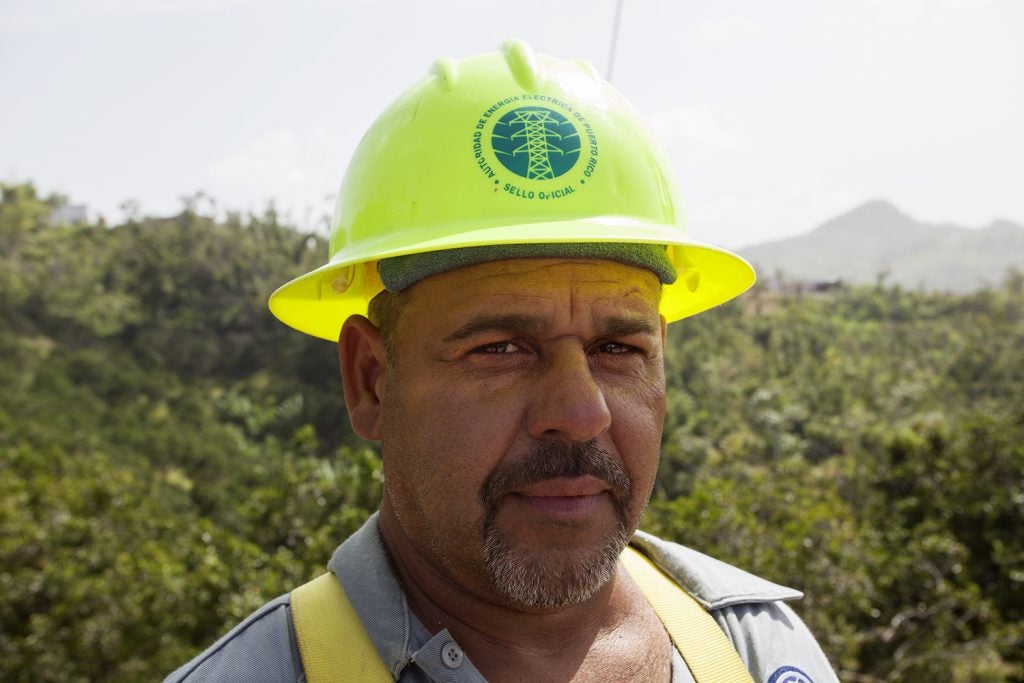
“We’re going little by little by little, raising them, raising, raising,” he said.
But the work here is complicated, slow. It’s remote. More than that, it’s full of trees. Where a cleared corridor should run under the transmission lines, grows an orange orchard.
Somewhere in the trees, a worker untangled the cable from the branches. Another man, mid-air in a bucket truck, cranked the cable tighter on the utility pole, elevating it.
Hurricane Maria brought down about 80 percent of the island’s transmission lines — those are the cables that transport energy long distances from the power plants to more localized distribution lines and, eventually, to customers. PREPA’s infrastructure was old and poorly maintained, but much of the damage during the storm came from trees falling and blowing into lines and towers.
Turns out, one of the most complicated pieces of technology – the power grid – is no match for a tree.
Giving power lines a “right of way”
Back in 2003, a massive blackout plunged much of the East Coast into darkness. An investigation found the root of the blackout was a tree hitting a transmission line in Ohio. Within a couple of years, lawmakers passed legislation requiring utilities to be more diligent about trimming back vegetation in the corridors below power lines. Those corridors are called right of ways.
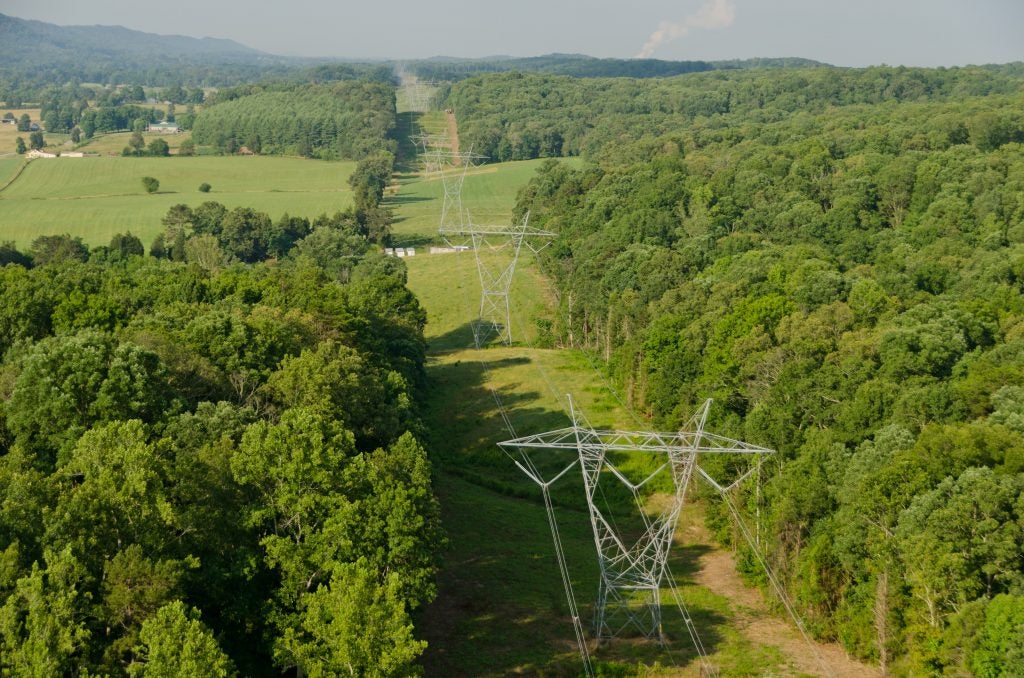
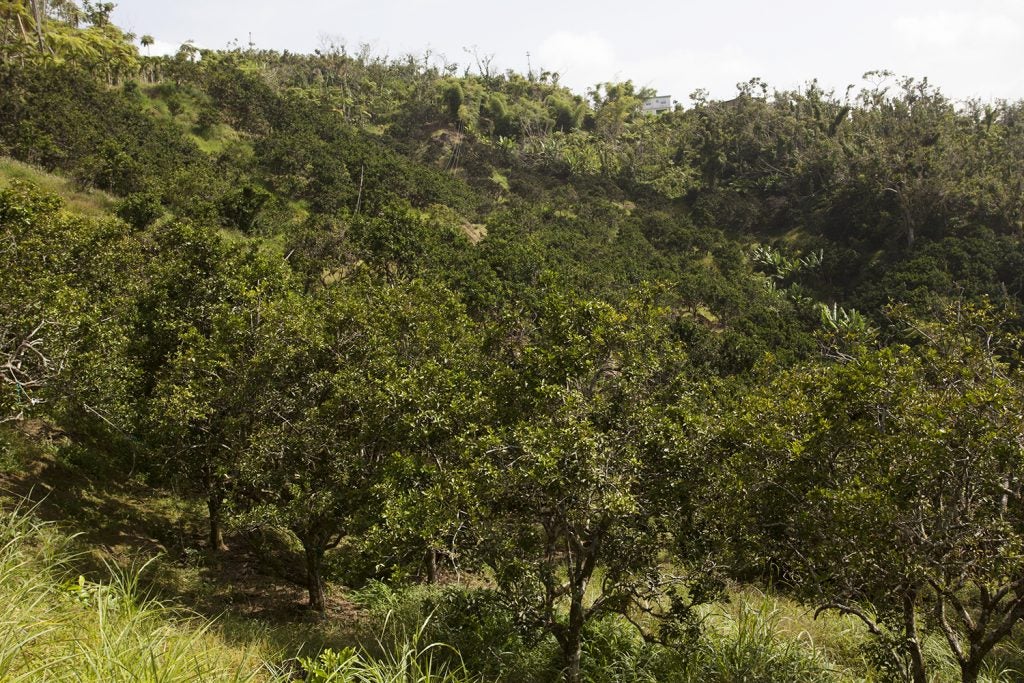
Today, these right of ways “often they look like a well maintained fairway on the golf course,” said Scott Aaronson, vice president for security and preparedness at the Edison Electric Institute, an advocacy group for power companies. “They’re going to be wide, and they are going to give plenty of room for the typical line movement.”
Often, utilities outsource the labor-intensive work of vegetation maintenance to contractors. A whole niche industry of tree trimmers flourishes on the mainland.
But the laws governing how utilities maintain their right of ways don’t apply in Puerto Rico. Aaronson toured some of the damaged lines by helicopter after Hurricane Maria. He says he saw “no real right of ways to speak of and no clear demarcation of where the rainforest is supposed to end and the transmission system was supposed to begin.”
Vegetation was a problem for the utility before the storm. Past studies showed that nearly half of all power outages in Puerto Rico stemmed from line contact with greenery. The storm brought the problem into sharper focus.
As wind and rain from Hurricane Maria picked up — branches flew into power lines, short circuiting them. Violent mudslides tossed trees onto power lines — and some lines broke under the weight. When the storm died down, remaining forest and debris made accessing lines difficult. Vegetation exacerbated the damage. And, to add insult to injury, it also made fixing the system more difficult.
A tangled task
When Puerto Rico started building its power grid in the 1940s, forest covered about 6 percent of the agriculture-dependent island. As it industrialized, land use changed. Today, forest grows on more than half of the island, taking over abandoned agricultural lands. And that jungle is lusty: it grows fast, year round.
The fact that locals love trees, can be a problem. People plant them for shade, their beauty and food, sometimes in places they shouldn’t, like the orchard where worker Julio Alvarado Feliciano struggled to reinstall lines.
The island’s mountainous interior, criss-crossed by transmission lines, complicates things, too.
Because the terrain is difficult and the growing season long, Mireya Rodriguez, who works in PREPA’s fiscal office, doesn’t think Puerto Rico can ever have manicured corridors like those on the mainland.
Maintenance used to be more consistent. The utility used to have vegetation management crews, who followed trimming plans. Much of that has been replaced by reactive work; crews say their most common calls now are to fix lines and transformers damaged by trees.
In part, that’s because the utility is in serious financial trouble. It’s about $9 billion in debt. For years, PREPA has been cutting spending and staff. Often, as people quit or retire, they’re not replaced.
Alexis Hernandez is a 30-year veteran at PREPA. In a little restaurant in the town of Utuado — over a meal of rice and beans with chicken — Hernandez said his region used to have 60 or 70 employees. Now, if 15 show up, it’s a lot. He’s supposed to be a heavy equipment operator, but finds himself clearing vegetation.
“We have more work and few employees,” Hernandez said.
And there will be one less, soon. He’s already put in his retirement notice.
“I should’ve gone already,” he said. “But I haven’t been able to because of the emergency. As soon as they let me, I’m going.”
Solutions
PREPA’s Mireya Rodriguez says the utility must do better.
“We are trying to avoid to get to a similar situation with a future storm,” she said.
Improving vegetation management is the utility’s number one priority right now, “because it’s a reliability issue,” she said.
The utility wants to outsource the work, similar to what many utilities do on the mainland. About 30 percent of the total maintenance budget — or $50 million —will go towards vegetation management efforts. Unlike the mainland, there’s no established outside industry to do that work on the island.
Back at the restaurant, Hernandez reminisced about all he’s seen in his decades working on the power lines: There are the pretty views from mountaintops. There are the mudslides that send lines and poles tumbling.
He remembered coming across something that kind of epitomized the utility’s challenge with nature: a yagrumo tree, an early settler in new forests, had grown around a utility pole, swallowing it entirely.
“They became one,” he said. “We left it alone and put up another utility pole. We left it, didn’t touch it.”
That time, they let nature win.
This reporting was made possible by the Fund for Environmental Journalism of the Society of Environmental Journalists.
WHYY is your source for fact-based, in-depth journalism and information. As a nonprofit organization, we rely on financial support from readers like you. Please give today.




